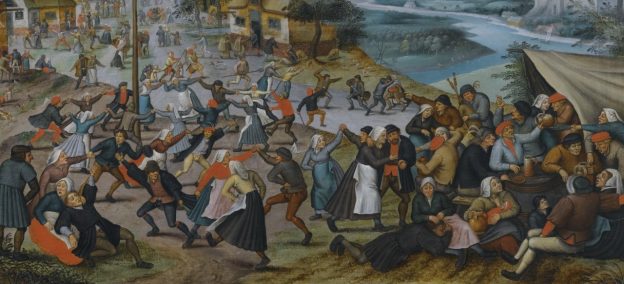On Jan 10th Tim Healey gave us a fascinating and entertaining account of the customs associated with May Day celebrations.
First of all he reminded us that the First of May is not only a celebration of Spring, but also a political date, even with revolutionary undertones.
But May Day celebrations have their origins in the pagan rites associated with Flora the goddess of flowers, which began in Roman times and may have been connected to orgies. A painting by Tiepolo of 1745 depicted these rites.
In 1695 Anthony Wood described the celebrations as an invocation of Summer and at this time it was not considered of great significance. However in the period of the Commonwealth many Puritans found the practice abhorrent, and they did their best to suppress any celebration connected with May Day.
Singing from towers became a common custom in Medieval times and was known to take place in Oxford on New College Bell Tower. The urge to bring green things into the towns and indoors was also a feature of these rites and is depicted in a Book of Hours of 1500. In the Thames Valley the Hawthorn and its blossom were very popular for garlands. It often (but not always) flowered at the appropriate time.
The Celtic Beltane feasts and Valpurgisnacht were also associated with May Day rites.
In 1250 the University banned all Maytime revels and this reflected the tension which developed between Authority and the revellers. But the Church attitude was often ambiguous, partly since the profits from the sale of Church Ale were used to fund church maintenance. The University colleges, too, sometimes hosted the Morris Dancing. In 1605 there was Morris Dancing in front of the King at Christchurch college.
In the 16th century we see the first mentions of Morris Dancing in relation to May Day celebrations, including depictions of men dressed as women (which had been forbidden in the Bible).
The Puritan backlash against Morris Dancing and other forms of popular entertainment originated with the English Church’s break with Rome in the 16th Century. The Bible was the supreme arbiter, and anything that was condemned there was abhorrent to the Puritans. Banbury was a hotbed of Puritanism, and the authorities there forbade all May celebrations. The Royalists considered these things to be harmless. In 1633 St Peter’s Church tried to stop a Garland from coming into the Church. The Maypole was often erected as a provocation to the Puritans.
At the Westminster Assembly in 1644 Maypoles were banned, but at the Restoration, and the return of Charles II, they reappeared.
By the 1740s the revelries around the Maypole had become more “polite” and in tune with the new Romantic sensibility. The dancers began to include women and girls, and small boys blowing horns (the whithorns) as they might have done in the fields while herding cattle and sheep. On Magdalen College Tower the Choir sang the Hymnus Eucharistus.
In the 19th Century, with the Industrial Revolution in full swing, the popular image of the Countryside became more and more idealised, and writers and artists (including Tennyson, Holman Hunt and Ruskin) helped to create the image of May Day revels that we recognise today. The Maypole became an object with ribbons round which people danced, a Garland was brought in, the May Queen appeared (only occasionally with a May King), and songs were written and sung. But still there were more subversive elements, such as Jack in the Green, a man covered from head to foot with greenery, and often accompanied by chimney sweeps.
In the 20th and 21st Centuries the trend towards popular involvement increased, with events such as the Magdalen Bridge celebrations as the Choir sings from Magdalen Tower, followed by further revels up the High Street. This particular event attracts people in huge, sometimes frightening numbers. But on the other hand, May Day is still celebrated in small communities with dances round the May Pole, a Queen of the May, and garlands from the countryside.

